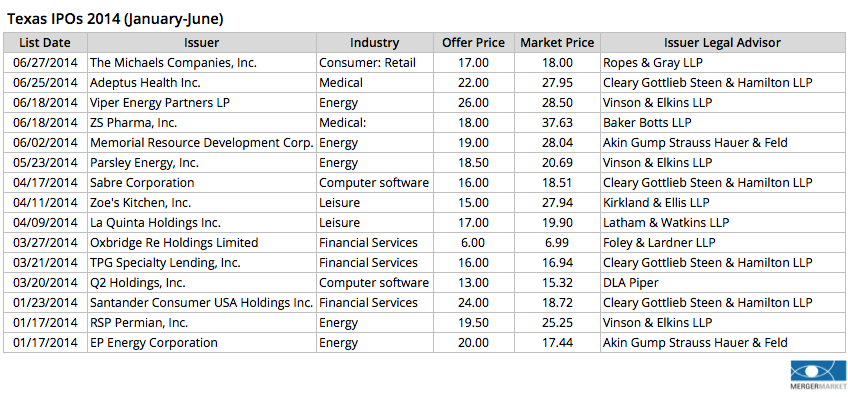© 2014 The Texas Lawbook.
By Bill Howell – (September 16) – A strong market for initial public offerings has long been seen as a bellwether for good times in the broader market. When companies are going public, the perception is that investors, management teams and bankers have confidence in the market and its prospects.
New companies access the public markets to fuel growth opportunities, and the wealth that can be generated by a completed IPO often trickles down to other segments of the economy like real estate.
While a strong IPO market signals a strong broader market, the reverse can also be true.

According to IPO investment firm Renaissance Capital (www.renaissancecapital.com), in 2008, when the capital markets crashed and the bottom fell out of the economy, only 31 IPOs priced.
Despite significant improvements in the U.S. economy in 2011 and 2012, only 125 and 128 IPOs priced in those years, respectively, materially fewer than the 213 that priced in 2007.
However, if the first half of 2014 is any indication, the IPO market appears to have fully recovered from the stock market crash of 2008.
The number of IPOs priced in 2013 reached 222, more than any other year since 2005, and we are on pace to surpass that number in 2014. Interestingly, despite the fact that 94 more IPOs priced in 2013 than 2012, both years started in much the same way.
In the first half of 2013, 72 IPOs priced, compared to the 73 IPOs that priced in the first half of 2012.
What this really means is that the true recovery began in the second half of 2013, when 150 deals were priced. That momentum has continued to drive the IPO market into this year with 147 deals pricing already in the first half of 2014, which already exceeds the total number of IPOs priced in each of 2011 and 2012.
In Texas, the story is similar to what we are seeing in the broader U.S. market.
According to Mergermarket, 16 Texas-based companies priced initial public offerings in the first half of 2014. This is a marked improvement over the five Texas companies that priced IPOs in the first half of 2013.
Again, however, as was the case in the broader U.S. market, in Texas the first half of 2013 told a very different story than the second half of 2013 when 16 companies headquartered in Texas priced IPOs.
Although the bump in IPOs that began in the second half of 2013 is not attributable to one particular industry, pharmaceutical companies have led the way the last couple of years in the U.S. According to Mergermarket, in 2012 only seven pharmaceutical companies priced IPOs.
That number jumped to 22 in 2013 and, in the first half of 2014, 28 pharmaceutical companies have already priced IPOs. Other industries that have seen an uptick include computer software, which represented 16 IPOs in 2012, 19 in 2013 and 15 in the first half of 2014, and financial services, which had 12, 19 and 15 during the same periods, respectively.
In Texas it is no surprise that energy firms continue to lead the way.
There were eight energy IPOs in Texas in 2012, nine in 2013 and already five in the first half of 2014. No other industry accounted for more than two IPOs in Texas during either 2012 or 2013, and only financial services, with three, has generated more than two IPOs in the first half of 2014.
The difference may be that the resurgence in IPOs in Texas is spread more broadly across multiple industries. In 2012 and 2013, energy company IPOs represented approximately 47% and 43%, respectively, of all IPOs priced in Texas. In the first half of 2014, although energy still had the largest share of IPOs, only 31% of the IPOs priced were by energy companies.
Despite the fact that energy companies represented a reduced percentage of the total number of IPOs in the first half of 2014, the size of the energy industry IPOs still generally tends to be much larger than those of companies in other industries.
Leading the way in the first half of 2014 in Texas were Parsley Energy, which raised $925 million, Memorial Resource Development Corp., which raised more than $800 million, and EP Energy, which raised over $700 million.
By contrast, companies such as ZS Pharma, which is a pharmaceuticals company, and Zoe’s Kitchen, a restaurant company, raised $107 million and $87 million, respectively.
The largest IPO in Texas in the first half of 2014 was completed by Santander Consumer USA Holdings, a consumer finance company that raised $1.8 billion.
If the IPO market is truly back and the improvement is spread across multiple industries, then what is driving this growth? Is it just the IPO market catching up with the improving general economic conditions?
Is it the passing of the Jumpstart Our Business Startups Act (JOBS Act), which relaxed the registration requirements for “emerging growth companies”? Is it continued low interest rates that are offering investors few options to realize returns in other segments of the market?
The truth is that it is probably some combination of all of these factors and more. One thing that seems to be driving activity in Texas is pent up demand from private equity firms that have held investments longer than usual.
Two such examples are Michaels Holdings and La Quinta Holdings. Michaels, which owns Michaels Stores, was acquired by private equity firms Bain Capital and Blackstone in 2006. La Quinta was also acquired by Blackstone in 2006.
Although there is no hard and fast rule regarding how long private equity companies expect to hold their investments, eight years is clearly longer than the typical hold period you would expect for firms like Bain and Blackstone.
It remains to be seen whether the pace of IPOs from the first half of 2014 can continue into the second half of the year or whether we’ll see a mid-year shift like we saw in 2013. However, the overall strength in the capital markets and the broader economy appear to position the IPO market for continued success.
One thing many experts are pointing to as a driver for IPOs in the second half of the year, is the expected debut of Chinese online retailer Alibaba. Alibaba has been hotly anticipated and, if it raises the approximately $20 billion that is currently expected, it would represent the largest IPO ever. Building on the momentum from the first half of the year, a successful Alibaba IPO would almost certainly mean a strong 2014 for the IPO market.
However, as we’ve seen before, the IPO market can be fickle. Any speed bumps in the domestic economy or escalation in international conflicts like those ongoing in Israel, Ukraine and Iraq, can change the landscape quickly.

Bill Howell is a corporate and securities law partner in the Dallas office of Baker Botts. His practice focuses on capital markets and mergers and acquisitions. His full bio can be read at www.bakerbotts.com/william-d-howell.
© 2014 The Texas Lawbook. Content of The Texas Lawbook is controlled and protected by specific licensing agreements with our subscribers and under federal copyright laws. Any distribution of this content without the consent of The Texas Lawbook is prohibited.
If you see any inaccuracy in any article in The Texas Lawbook, please contact us. Our goal is content that is 100% true and accurate. Thank you.
